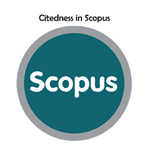Analisa Prediksi Farmakokinetik Dan Toksisitas Efek Antikanker Payudara Pada Temulawak (Curcuma Zanthorrhiza) Secara In Silico
Abstract
Keywords
Full Text:
PDFReferences
P. Lestari and Wulansari, "Pentingnya Pemeriksaan Payudara Sendiri ( SADARI ) Sebagai Upaya Deteksi Dini Kanker Payudara" Indones. J. Community Empower., vol. 1161, pp. 55-58, 2018, [Online]. Available: http://jurnal.unw.ac.id:1254/index.php/IJCE/article/view/327
N. H. Apriantoro, Y. Kartika, R. Kurniawan, K. Kunci, and K. Payudara, "Teknik Radioterapi Kanker Payudara Post Mastektomi Dengan Teknik Intensity Modulated Radiation Therapy" Indones. J. Heal. Sci., vol. 7, no. 1, pp. 22-28, 2023.
A. Wilapangga, "Analisis Potensi Farmakokinetik dan Toksisitas Pada Curcumin ( Curcuma xanthorrhiza ) Sebagai Brightening Terhadap Reseptor Protein Tirosinase Secara in Silico" vol. 3, no. 2, pp. 203-211, 2023, doi: 10.37311/ijpe.v3i2.18878.
R. Rahmadansah, D. S. Rahayu, and F. Raisyadikara, "Meta-analysis on extraction methods , pharmacological activities , and cultivation techniques of Curcuma xanthorrhiza Roxb ." vol. 51, no. August, pp. 163-172, 2023.
B. Jaydip and S. Vraj, "Identification of potent COVID-19 Main Protease (Mpro) inhibitors from Curcumin analogues by Molecular Docking Analysis" Int. J. Adv. Res. Ideas Innov. Technol., vol. 6, no. 2, pp. 664-672, 2020.
S. Servida et al., "Overview of Curcumin and Piperine Effects on Glucose Metabolism: The Case of an Insulinoma Patient's Loss of Consciousness" Int. J. Mol. Sci., vol. 24, no. 7, 2023, doi: 10.3390/ijms24076621.
M. Dahlgren et al., "CITED1 as a marker of favourable outcome in anti-endocrine treated, estrogen-receptor positive, lymph-node negative breast cancer" BMC Res. Notes, vol. 16, no. 1, pp. 1-9, 2023, doi: 10.1186/s13104-023-06376-1.
H. Widya, P. Sabandar, H. Purnomo, and I. Arifin, "MOLECULAR DOCKING SENYAWA JAMBU BIJI ( Psidium guajava L .) TERHADAP RESEPTOR ESTROGEN ALFA SEBAGAI MODEL KANDIDAT ANTIKANKER PAYUDARA" no. 1, pp. 19-27, 2023.
A. Mukherjee, K. M. Pandey, K. K. Ojha, and S. K. Sahu, "Identification of possible SARS-CoV-2 main protease inhibitors: in silico molecular docking and dynamic simulation studies" Beni-Suef Univ. J. Basic Appl. Sci., vol. 12, no. 1, 2023, doi: 10.1186/s43088-023-00406-4.
M. A. Manavi, "In silico Study to Identification of Potential SARS-CoV-2 Main Protease Inhibitors: Virtual Drug Screening and Molecular Docking with AutoDock Vina and Molegro Virtual Docker" J. Cell Mol. Res., vol. 13, no. 2, pp. 108-112, 2022, doi: 10.22067/jcmr.2021.71517.1013.
L. Kagami, A. Wilter, A. Diaz, and W. Vranken, "The ACPYPE web server for small-molecule MD topology generation" Bioinformatics, vol. 39, no. 6, pp. 4-6, 2023, doi: 10.1093/bioinformatics/btad350.
V. Perumalsamy, D. R. Harish Kumar, and S. Suresh, "Conjugation of Curcumin and Metformin for Improved Pharmacological Profile in Cancer Therapy: An In Silico Approach" Biointerface Res. Appl. Chem., vol. 13, no. 2, pp. 1-15, 2023, doi: 10.33263/BRIAC132.101.
E. F. F. Anjas Wilapangga 1, Suci Wulan Sari 2, "Jurnal Bina Cipta Husada Vol . XIX , No . 1 Januari 2023 ANALISIS POTENSI FARMAKOKINETIK DAN TOKSISITAS KANDIDAT OBAT DARI EKSTRAK DAUN SALAM ( Syzygium polyanthum ) SEBAGAI ANTIOKSIDAN SECARA IN SILICO PENDAHULUAN Banyaknya permasalahan yang dirasakan ol" vol. XIX, no. 1, pp. 47-54, 2023.
E. B. Aksono, A. C. Latifah, L. T. Suwanti, K. U. Haq, and H. Pertiwi, "Clove Flower Extract (Syzygium aromaticum) Has Anticancer Potential Effect Analyzed by Molecular Docking and Brine Shrimp Lethality Test (BSLT)" Vet. Med. Int., vol. 2022, 2022, doi: 10.1155/2022/5113742.
D. Dermawan, R. Sumirtanurdin, and D. Dewantisari, "Molecular Dynamics Simulation Estrogen Receptor Alpha againts Andrographolide as Anti Breast Cancer" Indones. J. Pharm. Sci. Technol., vol. 6, no. 2, p. 65, 2019, doi: 10.24198/ijpst.v6i2.18168.
J. W. Song, Y. S. Liu, Y. R. Guo, W. X. Zhong, Y. P. Guo, and ..., "Nano-liposomes double loaded with curcumin and tetrandrine: Preparation, characterization, hepatotoxicity and anti-tumor effects" Int. J. "¦, 2022, [Online]. Available: https://www.mdpi.com/1422-0067/23/12/6858
Q. He et al., "Exploring the mechanism of curcumin in the treatment of colon cancer based on network pharmacology and molecular docking" Front. Pharmacol., vol. 14, no. February, pp. 1-16, 2023, doi: 10.3389/fphar.2023.1102581.
DOI: https://doi.org/10.37311/ijpe.v3i3.22203
Refbacks
- There are currently no refbacks.
Copyright (c) 2023 Errol Rakhmad Noordam

Indonesian Journal of Pharmaceutical Education is licensed under a Creative Commons Attribution-NonCommercial-ShareAlike 4.0 International License.



